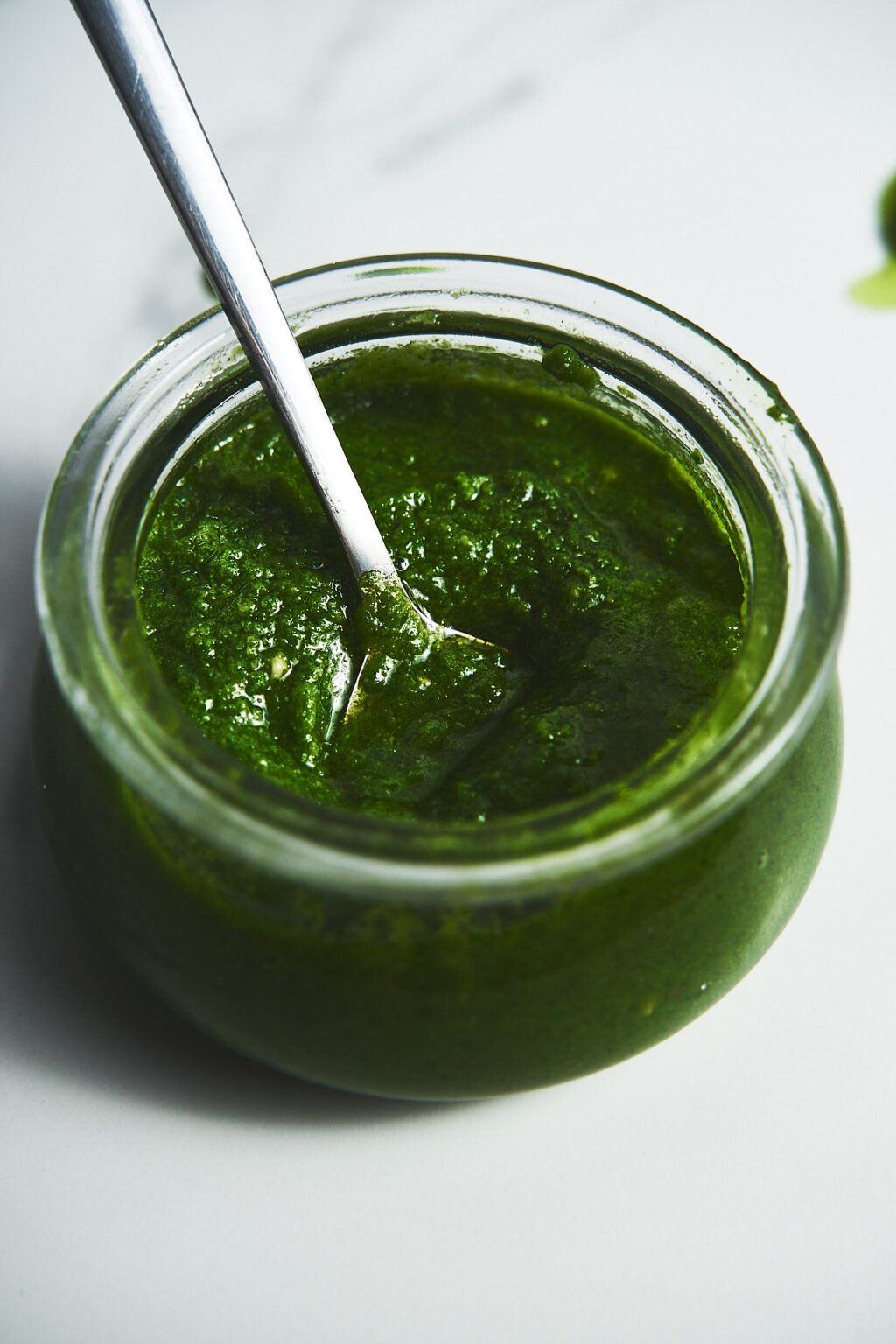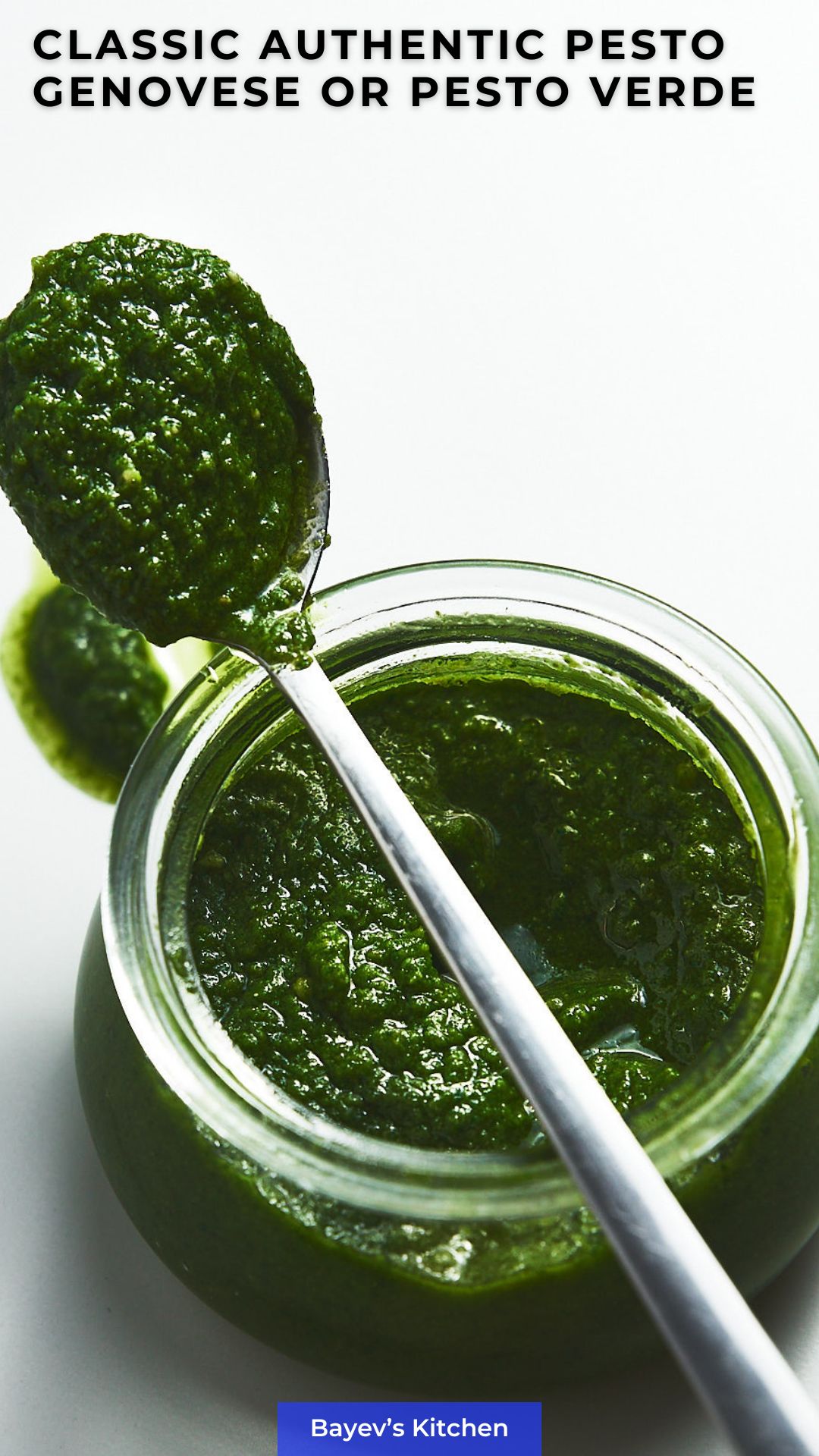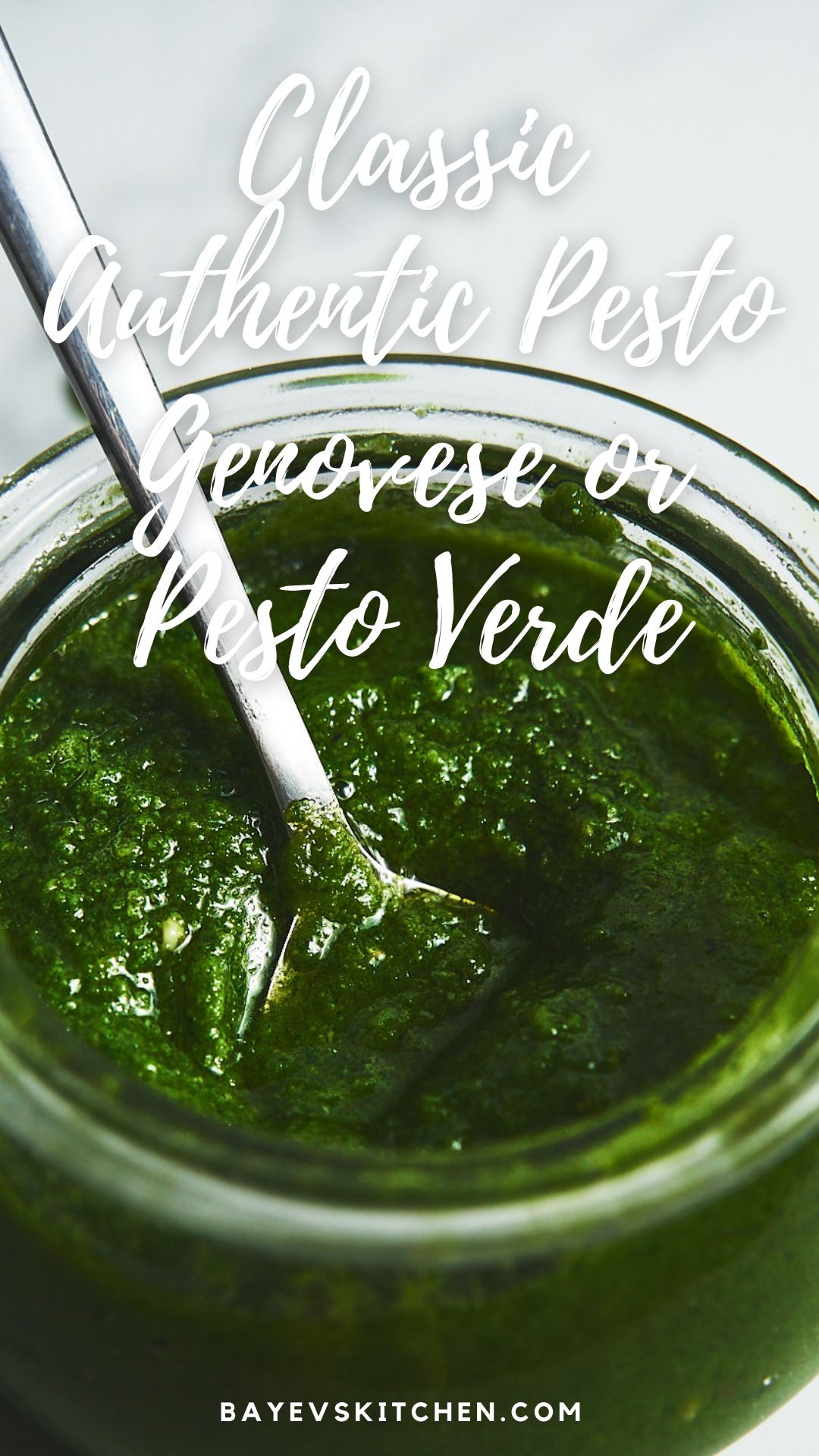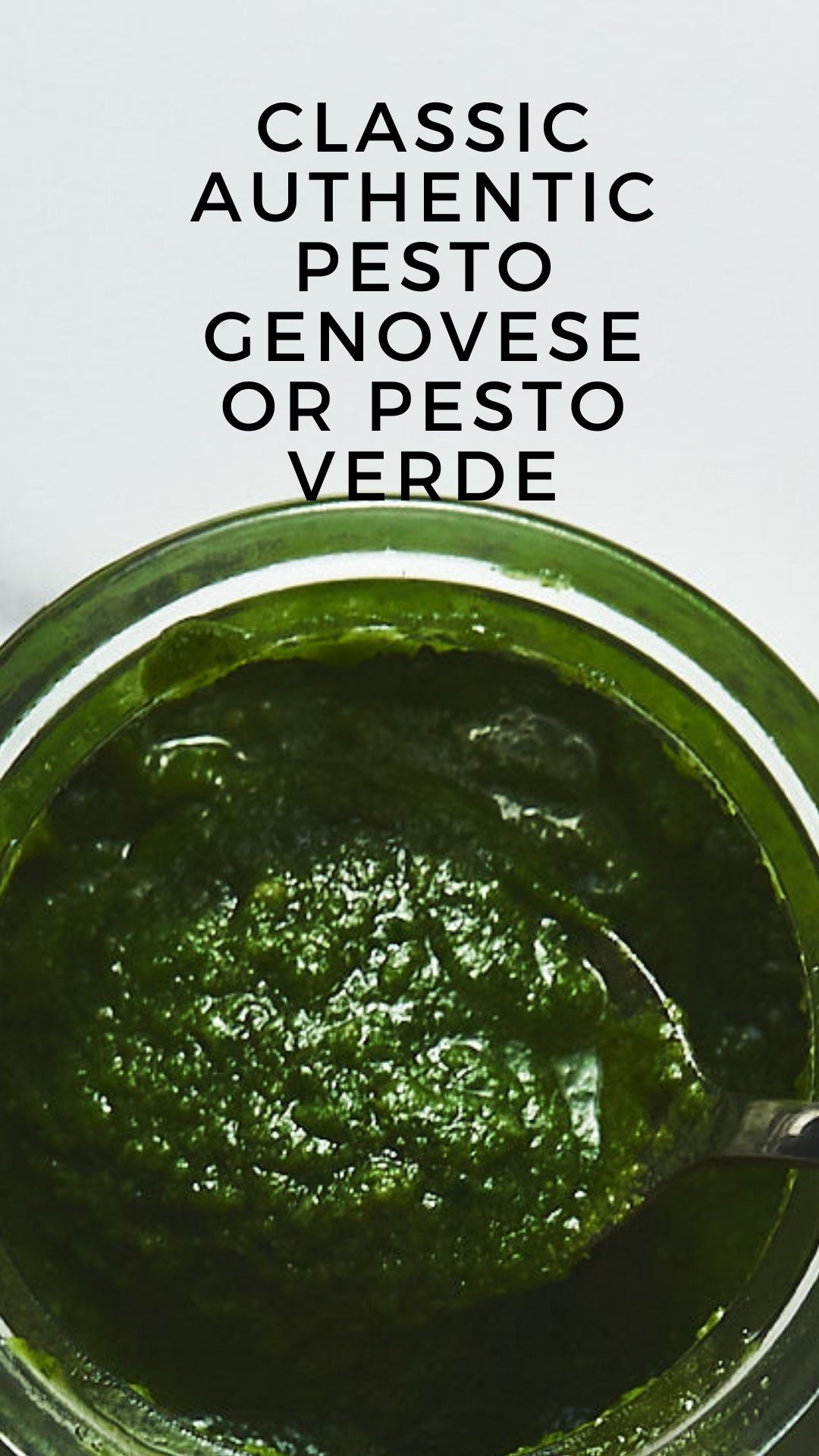Delicate and t the same time rich, simple but with multi-layered flavors – this is Pesto Genovese. A juicy green sauce from the heart of Italy, a timeless classic that knows no bounds.
To begin with, I suggest to understand the definitions.
Pesto, translated from Italian, means “to grind” or “crush”, such a name was given to the sauce because of the traditional way of making it with a mortar and pestle.
There are many variations of pesto, each originating from a different region of Italy and beyond.
Pesto Verde is “green pesto” and can refer to any green sauce made by chopping.
Pesto Genovese is a classic Italian pesto from Genoa consisting of basil, olive oil, pine nuts, cheese and garlic. In fact, pesto Genovese is a specific type of pesto verde, which is what we’re going to make today.
The sharp and slightly spicy note of garlic combines with the creaminess of cheese to create a rich range of flavors. Olive oil binds these flavors together, adding fruity notes, and salt enhances the individual character of each ingredient.
This recipe stays true to the original, providing a rich, creamy consistency and authentic flavor profile. It is versatile and can be used as a sauce, dip or dressing.
Pesto Verde is traditionally served with pasta, but is also great with grilled vegetables, chicken, or simply spread on a slice of crusty bread.
Contents

⏱ Cooking time — 10 minutes overall. Includes 10 minutes of preparation and cooking + 0 minutes unattended.
🔪 Ingredients
- 60 g (2 ⅛ oz) fresh basil leaves
- 50 g (1 ¾ oz) pine nuts
- 2 large garlic cloves
- 60 g (2 ⅛ oz) freshly grated Parmesan cheese
- 130 ml (8 ⅘ tbsp.) extra virgin olive oil
- 1 tsp. salt to taste

🥣 Directions
👉 Jump to Short Version of RecipeIngredient Preparation
Remove the hard part of the basil stalk (if desired).
Grate 60 g (2 ⅛ oz) Parmesan cheese thoroughly on a fine grater.
Chopping ingredients with a blender
Place basil leaves, 50 g (1 ¾ oz) pine nuts, 2 large garlic cloves (just peeled) in the bowl of a blender.
Turn the blender on low power and chop the ingredients inside for 15 seconds.
Adding the rest of the components
Open the lid, stir the mixture gently with a spoon or spatula, then add a little olive oil.
Sprinkle the parmesan cheese over everything. Season with a pinch of salt to taste. Stir well with a spatula.
Turn the blender back on. Pour in the remaining olive oil in a thin stream.
Transferring the finished pesto and storing
Turn off the blender, carefully transfer the pesto to a storage container.
Use immediately or store in the refrigerator.

🙋♂️ FAQ
Can I substitute pine nuts with other nuts?
While pine nuts are traditional for this recipe, you can substitute them with almonds or walnuts for a slightly different taste. However, note that this will change the authentic flavor of the Pesto Genovese.
How long can Pesto Genovese be stored?
Pesto can be stored in an airtight container in the refrigerator for up to one week. Ensure the pesto’s surface is covered with a thin layer of olive oil to prevent oxidation.
Can I use a food processor instead of a mortar and pestle?
Traditionally, a mortar and pestle are used to achieve the desired texture and to ensure a gentle blending of ingredients. However, a food processor can be used for convenience, though the texture and flavor might slightly differ.
How do I serve Pesto Genovese?
Pesto Genovese is typically served with pasta, especially with linguine or trofie. It can also be used as a spread for sandwiches, a dressing for salads, or a garnish for grilled vegetables.
The color of my pesto is turning dark. Is it still safe to eat?
If the pesto turns a darker green or brown, it’s due to oxidation. While it’s still safe to eat, the flavor can be slightly different. To prevent this, ensure the pesto is covered with a thin layer of olive oil.
Can I make Pesto Genovese vegan?
Yes, you can replace the Parmesan and Pecorino cheese with nutritional yeast or vegan cheese to give it a cheesy flavor without any dairy.
My pesto tastes too garlicky. How can I adjust it?
If your pesto is too garlicky, you can balance it out by adding more basil, nuts, and cheese. Remember to add garlic gradually and taste as you go.
Can I freeze Pesto Genovese for later use?
Absolutely! Pesto Genovese freezes well. Just skip adding the cheese if you’re freezing and add it freshly when you decide to use the pesto. Store in airtight containers or ice cube trays for convenience.
Why is my pesto bitter?
Bitterness can arise from over-processed basil or older basil leaves. Always use fresh basil and avoid over-blending in a processor.
Can I use dried basil instead of fresh basil leaves?
It’s highly recommended to use fresh basil for an authentic and vibrant flavor. Dried basil won’t give the same taste or texture.
What other dishes can I make using Pesto Genovese?
Apart from pasta, you can use Pesto Genovese in dishes like potato gnocchi, grilled chicken, baked or grilled fish, pizza, and risotto.
Can I use Pesto Genovese as a marinade?
Yes, Pesto Genovese works great as a marinade for meats, especially chicken, or fish due to its rich flavor profile.
Why is it called “Genovese”?
The name “Genovese” indicates its origin from Genoa, the capital city of Liguria, Italy, where the recipe was first developed.
Does Pesto Genovese contain gluten?
No, Pesto Genovese is naturally gluten-free, but always ensure to check ingredient labels if you’re buying pre-made pesto or using it in dishes to cater to those with gluten sensitivities.
Is there a difference between Pesto Genovese and other types of pesto?
Yes, while the term “pesto” refers to any sauce made by grinding ingredients together, Pesto Genovese is specific to the basil-based sauce from Genoa. Other types of pesto might use different main ingredients, like sun-dried tomatoes, arugula, or even avocado.
📌 Pin it!




Classic Authentic Pesto Genovese or Pesto Verde

Ingredients
- 60 g fresh basil leaves
- 50 g pine nuts
- 2 large garlic cloves
- 60 g freshly grated Parmesan cheese
- 130 ml extra virgin olive oil
- 1 tsp. salt
Instructions
- Remove the stems from the basil. Grate the Parmesan on a fine grater.
- Place the basil leaves, pine nuts and peeled garlic cloves in the blender bowl. Run the blender for 15 seconds and chop all the ingredients.
- Add some of the olive oil, the entire amount of parmesan and season with salt. Start the blender, gradually pouring in the remaining oil.
- Transfer the finished pesto to a container. Use immediately or store in the refrigerator.
